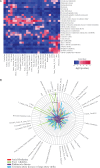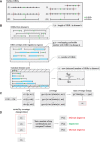GARLIC: a bioinformatic toolkit for aetiologically connecting diseases and cell type-specific regulatory maps
- PMID: 28007912
- PMCID: PMC5409087
- DOI: 10.1093/hmg/ddw423
GARLIC: a bioinformatic toolkit for aetiologically connecting diseases and cell type-specific regulatory maps
Abstract
Genome-wide association studies (GWAS) have emerged as a powerful tool to uncover the genetic basis of human common diseases, which often show a complex, polygenic and multi-factorial aetiology. These studies have revealed that 70-90% of all single nucleotide polymorphisms (SNPs) associated with common complex diseases do not occur within genes (i.e. they are non-coding), making the discovery of disease-causative genetic variants and the elucidation of the underlying pathological mechanisms far from straightforward. Based on emerging evidences suggesting that disease-associated SNPs are frequently found within cell type-specific regulatory sequences, here we present GARLIC (GWAS-based Prediction Toolkit for Connecting Diseases and Cell Types), a user-friendly, multi-purpose software with an associated database and online viewer that, using global maps of cis-regulatory elements, can aetiologically connect human diseases with relevant cell types. Additionally, GARLIC can be used to retrieve potential disease-causative genetic variants overlapping regulatory sequences of interest. Overall, GARLIC can satisfy several important needs within the field of medical genetics, thus potentially assisting in the ultimate goal of uncovering the elusive and complex genetic basis of common human disorders.
© The Author 2016. Published by Oxford University Press.
Figures




Similar articles
-
Human aging in the post-GWAS era: further insights reveal potential regulatory variants.Biogerontology. 2015 Aug;16(4):529-41. doi: 10.1007/s10522-015-9575-y. Epub 2015 Apr 17. Biogerontology. 2015. PMID: 25895066
-
Lost in the space of bioinformatic tools: a constantly updated survival guide for genetic epidemiology. The GenEpi Toolbox.Atherosclerosis. 2010 Apr;209(2):321-35. doi: 10.1016/j.atherosclerosis.2009.10.026. Epub 2009 Oct 29. Atherosclerosis. 2010. PMID: 19963217 Review.
-
Bioinformatics tools for single nucleotide polymorphism discovery and analysis.Ann N Y Acad Sci. 2004 May;1020:101-9. doi: 10.1196/annals.1310.011. Ann N Y Acad Sci. 2004. PMID: 15208187 Review.
-
Translating genome wide association study results to associations among common diseases: in silico study with an electronic medical record.Int J Med Inform. 2013 Sep;82(9):864-74. doi: 10.1016/j.ijmedinf.2013.05.003. Epub 2013 Jun 3. Int J Med Inform. 2013. PMID: 23743324
-
Database tools in genetic diseases research.Genomics. 2013 Feb;101(2):75-85. doi: 10.1016/j.ygeno.2012.11.001. Epub 2012 Nov 10. Genomics. 2013. PMID: 23147677 Review.
Cited by
-
Distinct IL-1α-responsive enhancers promote acute and coordinated changes in chromatin topology in a hierarchical manner.EMBO J. 2020 Jan 2;39(1):e101533. doi: 10.15252/embj.2019101533. Epub 2019 Nov 7. EMBO J. 2020. PMID: 31701553 Free PMC article.
References
-
- Botstein D., Risch N. (2003) Discovering genotypes underlying human phenotypes: past successes for mendelian disease, future approaches for complex disease. Nat. Genet., 33 Suppl, 228–237. - PubMed
-
- McCarthy M.I., Abecasis G.R., Cardon L.R., Goldstein D.B., Little J., Ioannidis J.P.A., Hirschhorn J.N. (2008) Genome-wide association studies for complex traits: consensus, uncertainty and challenges. Nat. Rev. Genet., 9, 356–369. - PubMed
Publication types
MeSH terms
LinkOut - more resources
Full Text Sources
Other Literature Sources
Medical

